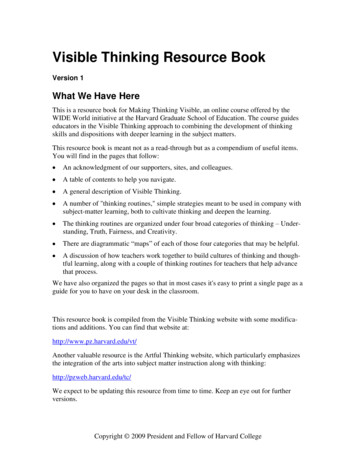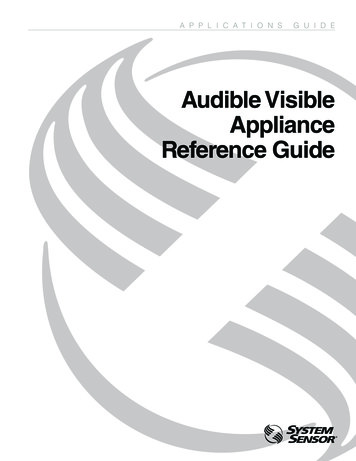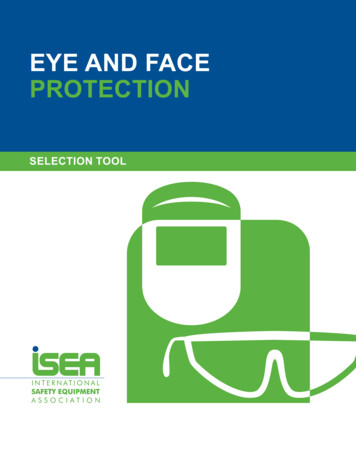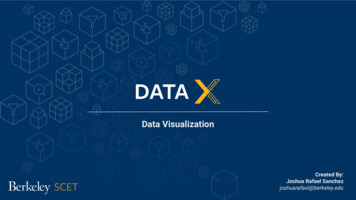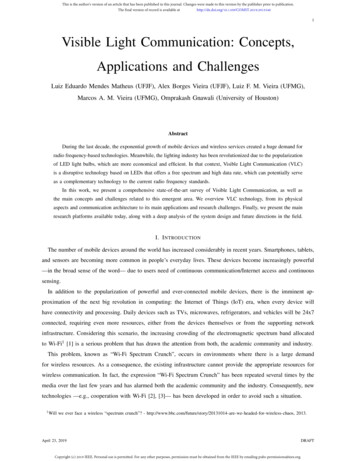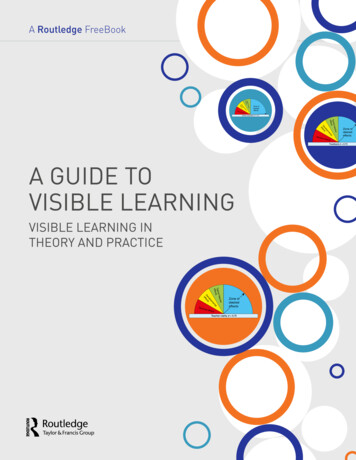
Transcription
A Routledge FreeBookcheral teaTypicltstaeffecenpmlove tsD e eceffReverse effectsZone ofZONE OFdesiredDESIREDeffectsEFFECTSStudent expectation d 1.44al teTypicseffectacheltaense effectsrpmlove tsDe fecefReverZone ofZONE OFdesiredDESIREDeffectsEFFECTSFeedback d 0.75A GUIDE TOVISIBLE LEARNINGVISIBLE LEARNING INTHEORY AND PRACTICEalTypictseffecltaenrse effectserteachpmlove tsDe fecefReveZone ofZONE OFdesiredDESIREDeffectsEFFECTSTeacher clarity d 0.75
TABLEOFCONTENTS003 INTRODUCTION006 1: WHAT IS VISIBLE LEARNING?from 10 Mindframes for Visible Learning:Teaching for Success010 2: INSIGHTS INTO VISIBLE LEARNINGfrom Visible Learning Insights023 3: I AM AN EVALUATOR OF MY IMPACTON STUDENT LEARNINGfrom 10 Mindframes for Visible Learning:Teaching for Success034 4: IS THERE A PURPOSE OF EDUCATION?from The Purposes of Education: A ConversationBetween John Hattie and Steen Nepper Larsen
INTRODUCTIONA GUIDE TO VISIBLE LEARNINGThis guide is for teachers and senior leaders who are new to the Visible Learningconcept or would like to refresh their knowledge. Containing a curated collection ofchapters from books within the series, it introduces some of the most importantfeatures that will help teachers to see the effects of what they do in the classroom sothat they can increase their impact and make a real difference to their students.CHAPTER 1 – WHAT IS VISIBLE LEARNING?This chapter provides an overview of the Visible Learning project, the culmination ofover 30 years work, synthesizing over 95,000 studies involving more than 300 millionstudents globally that explains the most significant evidence-based ideas about whatactually works in schools and is. Taken from 10 Mindframes for Visible Learning, itdefines the ten behaviours or mindframes that teachers need to adopt in order tomaximize student success.CHAPTER 2 – INSIGHTS INTO VISIBLE LEARNINGThis chapter, taken from Visible Learning Insights introduces the main features of thebook Visible Learning and its ten-year history. After reading this chapter you shouldbe able to answer the following questions: What is the research process used in Visible Learning? What is a meta-analysis? What is an effect size? What is the size of the data pool? How is Visible Learning structured? What is important when interpreting factors?CHAPTER 3 – I AM AN EVALUATOR OF MY IMPACT ON STUDENT LEARNINGTaken from 10 Mindframes for Visible Learning, this chapter discusses educationalexpertise and how it is shown. One of the most crucial questions is whether teacherswant to know about their impact and make it visible. Teachers who have setthemselves this goal and are consistently trying to implement it are fundamentallydifferent from teachers who do not ask themselves this question. “Visible Learning”and “Know thy impact” become the core message of this mindframe – and the coremessage of this book.ROUTLEDGE3ROUTLEDGE.COM
INTRODUCTIONA GUIDE TO VISIBLE LEARNINGCHAPTER 4 – IS THERE A PURPOSE OF EDUCATION?In this final chapter, taken from the latest book in the Visible Learning series, ThePurposes of Education (2020) authors John Hattie & Steen Nepper Larse discuss thepurpose of education and the need for the education for mankind.Please note that because this FreeBook is composed of excerpts from several VisibleLearning books, you may see references to other books or chapters. To delve deeperinto any of the ideas or concepts laid out in these chapters, use the discount codeJKL20 to get 20% off your order at www.routledge.comSome references from the original chapters have not been included in this text. For afully referenced version of each chapter, including footnotes, bibliographies, andendnotes, please see the published title.As you read through this FreeBook, you will notice that some excerpts referenceprevious chapters – please note that these are references to the original text and notthe FreeBook.ROUTLEDGE4ROUTLEDGE.COM
DO YOU WANT TO FINDOUT MORE ABOUTVISIBLE LEARNING?GET 20% OFF YOUR ORDER OF ANYVISIBLE LEARNING BOOK!USE DISCOUNT CODE JKL20 TO GET 20% OFFTHESE ROUTLEDGE EDUCATION TITLESS H O P N OWAbout Us: Routledge Education publishes a wide range of quality resources for teachers combining researchexpertise with tried and tested classroom practice. Incorporating the highly respected David Fulton andSpeechmark imprints, our books, resource packs and online products provide invaluable support andinspiration for the busy classroom teacher. From early years through primary and secondary, from SEND toSLT or visible learning to outdoor learning, we have resources to help from expert authors you can trust.
1C HA P T ERWHAT IS VISIBLELEARNING?This chapter is excerpted from10 Mindframes for Visible Learning: Teaching for SuccessBy John Hattie and Klaus Zierer 2018 Taylor & Francis Group. All rights reserved.PURCHASE A COPY HERE
CHAPTER 1WHAT IS VISIBLE LEARNING?ltaenrse effectscherpmlove tsDe eceffl teaTypicatseffecReveZone ofZONE OFdesiredDESIREDeffectsEFFECTSJohn Hattie and Klaus ZiererStudent expectation d 1.44Excerpted from 10 Mindframes for Visible Learning: Teaching for SuccessWHAT IS VISIBLE LEARNING?The work on the original Visible Learning meta-study took more than 15 to 20 yearsto complete. It involved analysing more than 800 meta-analyses composing around80,000 studies in which an estimated (because the number of test subjects is notalways stated in the meta-analyses) 250 million learners took part – and, as justnoted, the work on the Visible Learning project is not yet finished: A total of morethan 1,400 meta-analyses now have been analyzed to date, but little has changedabout the main messages of the study.Only meta-analyses relating the achievement outcomes are considered. Others aredoing similar work with respect to emotional and motivational outcomes(Korpershoek et al., 2016), how we teach (Hattie & Donoghue, 2016), and specialeducation students (Mitchell, 2014), and it would be wonderful if there were metasyntheses on retention to the last years of schooling, and physical and nutritionaloutcomes.Visible Learning seeks to get to the crux of this multitude of findings fromeducational research and identify the main messages by synthesizing meta-analyses.The aim is to move from “what works” to “what works best” and when, for whom, andwhy. The search to understand these moderators (when, whom, why) was key in thesearch, and that there were so few moderators was quite surprising. The searchinvolved first generating around 150 factors from the underlying meta-analyses, suchas “class size,” “teacher-student relationships,” “direct instruction,” and “feedback,”and then determining their effect size, which can be calculated via comparing theaverages of two conditions (e.g. a new vs. older curriculum, reducing class size from25–30 to 15–20) or by comparing students over time after some intervention. Thebeauty of effect sizes is that, once computed, they can be reasonably comparedacross many interventions. There are many excellent sources for understandingeffect sizes (Coe, 2012; Lipsey & Wilson, 2001). Like every other method, metaanalyses – and especially the innovative attempt in Visible Learning to construct asynthesis of meta-analyses – are, of course, not without their flaws, and it is,therefore, important to refer to some of these criticisms (cf. Snook et al., 2009; Zierer,2016b).The various influences generated from the multiple meta-analyses can be assignedto various domains: learners, family, school, teacher, curriculum, and teaching. Thetable below provides a summary of the procedure as a whole.ROUTLEDGE7ROUTLEDGE.COM
ltaenrse effectscherpmlove tsDe eceffl teaTypicatseffecReveZone ofZONE OFdesiredDESIREDeffectsEFFECTSStudent expectation d 1.44refer to some of these criticisms (cf. Snook et al., 2009; Zierer,2016b).CHAPTER1The various influences generated from the multiple meta-analysescan be assigned to various domains: learners, family, school, teacher,curriculum, and teaching.The table below provides a summary of theprocedure as a whole.1This summaryalready revealsan important finding: There areWHATIS VISIBLELEARNING?domains that have been the topic of much research, such as teachJohn Hattie and Klaus Zierering, and domains that have been the topic of fewer research syntheses, such as family. As important,therecan begreatvariationtheExcerpted from10 Mindframesfor VisibleLearning:Teaching infor Successdispersion of effect sizes within the domains: Whereas most of thefactorsin thedomainof anschool,for alreadyrevealsimportantTheredomains thathave anbeenthesizetopicofof 0.2,muchtheresearch,suchandofdomainshave beentheeffectfactorsin ewer researchsuchas family. As andimportant,can be ion”)0.90 there(“teachercredvariationin thedispersion of effectwithin theWhereasmost of theibility”).Understandingthissizesvarianceis domains:importantto buildingthefactorsin theof school,instance,are clusteredsize ofcase forthedomainimportanceofforteachermindframes aroundas oneanofeffectthe ffectsizesbetween0.12(“teacherunderlying factors underlying these many ingvariance nalysesincludedin the ceofteachermindframesasoneofthecriticalability of the effects can be shown in the following distribution (seeunderlyingfactors underlying these many influences.Figure 0.4).Across the 800 meta-analyses included in the meta-study, the variability of theeffects can be shown in the following distribution (see Figure CTORSMETA-ANALYSESSTUDIESOVERALLEFFECT 5210,12928,6420.390.310.230.470.450.43Table 1.1xixROUTLEDGE8ROUTLEDGE.COM
CHAPTER 1WHAT IS VISIBLE LEARNING?ltaenrse effectscherpmlove tsDe eceffl teaTypicatseffecJohn Hattie and Klaus ZiererZone ofZONE OFdesiredDESIREDeffectsEFFECTSStudent expectation d 1.44Excerpted from 10 Mindframes for Visible Learning: Teaching for SuccessPrefaceNumber of effects across 800 ative-0,20,00,41,0Effect sizeFIGUREDistributionof size.effectSource:size Hattie and Zierer (2017).Figure1.10.4Distributionof effectSource: Hattie and Zierer (2017).In many ways, this distribution shows that practically everything that happens inIn andmanyways, thiscandistributionshowsin academicthat practicallyeverythingschoolthe classroomlead to an increaseperformance.To put itthat happenstheweclassroomcanincreaseslead totheiran achievement.increase inanotherway, 90 toin95schoolpercent andof whatdo to rs,butthatisnotthecase. The ofacademic performance. To put it another way, 90 to 95 percentonlythingillustratesis that peoplelearning all theOnetime might– sometimeswhatwethisdoresultto ence”fortheirthat this would reassure us teachers, but that is not the case. The onlyfavouriteinfluence.many senses,preventthing thisresultInillustratesis youthatcannotpeopleare learning.learning all the time –sometimesThisalmostcanThekey notion,despitehowever,us.is thatwe helpsshould explainbe asking whyabout thestory everyoneunderlying thoseclaim “evidence”their favoriteinfluence.In manysenses,youinfluencesgreater thanforthe averageeffect com-paredwith g.average(but stillpositive). This is the Visible Learning story and has been wellThe keynotion,is thatshouldhere.be Theaskingaboutrehearsedin otherVisiblehowever,Learning booksandwenot recitedquestionthis derlyingsuccessinmakingastory underlying those influences greater than the average effect comdifferenceto thelearningof studentsof the educators.pared withthoseinfllivesuencesbelow– thethemindframesaverage effect(but still positive). This is the Visible Learning story and has been well rehearsedin other Visible Learning books and not recited here. The questionthis book addresses is related to the one big critical idea underlyingsuccess in making a difference to the learning lives of students – themindframes of the educators.9T L E DbookGEROUTLEDGE.COMHowRisO Uthisorganized?Against this backdrop, we would like to introduce several general
2C HA P T ERINSIGHTS INTOVISIBLE LEARNINGThis chapter is excerpted fromVisible Learning InsightsBy John Hattie and Klaus Zierer 2019 Taylor & Francis Group. All rights reserved.PURCHASE A COPY HERE
CHAPTER 2THE VISIBLE LEARNING STORYINSIGHTS INTO VISIBLE LEARNINGltaenrse effectscherpmlove tsDe eceffl teaTypicatseffecReveZone ofZONE OFdesiredDESIREDeffectsEFFECTSJohn Hattie and Klaus ZiererStudent expectation d 1.44Excerpted from Visible Learning InsightsREFLECTIVE TASKReflect on what you already know about Visible Learning: What is your impression ofthe book? Is it old wine in new skins? Do you see it as an enrichment? Are youentirely unfamiliar with it? Or does it make you angry?GOALS AND CONTENTThis chapter introduces the main features of the book Visible Learning and its tenyear history. First, the methodical approach is discussed, before the book’ssystematic is explained and some initial insights inferred. When you have read thischapter, you should be able to answer the following questions: What is the research process used in Visible Learning? What is a meta-analysis? What is an effect size? What is the size of the data pool? How is Visible Learning structured? What is important when interpreting factors?Although meta-analysis is a well-known and used tool in medicine, its use acrosseducational sciences is less well known – even though it was invented by aneducationalist! It is a quantitative-empirical research method, just like observation,survey, testing, etc. Unlike most research methods, meta-analysis does not deliverany new data but works with existing data. There are existing data (primary studies),re-analyses of existing data (secondary studies), and synthesis of many existing datastudies (meta-analysis). Meta-analysis is therefore used primarily in cases where aproblem has already been researched extensively and a number of quantitativeempirical results are available. Quite often, these results do not necessarily agreewith one another, so that the question arises: Which of the many primary studies iscorrect? This is exactly where meta-analysis starts: Its goal is to convert thismultitude of primary quantitative-empirical studies into one result; but it is just asimportant to understand the factors which can moderate or influence this overall“one result”. In other words, it is about the general message that may be derivedfrom the many primary studies.ROUTLEDGE11ROUTLEDGE.COM
CHAPTER 2THE VISIBLE LEARNING STORYINSIGHTS INTO VISIBLE LEARNINGltaenrse effectscherpmlove tsDe eceffl teaTypicatseffecReveZone ofZONE OFdesiredDESIREDeffectsEFFECTSJohn Hattie and Klaus ZiererStudent expectation d 1.44Excerpted from Visible Learning InsightsDEFINITION OF A META-ANALYSISA meta-analysis is a combination of existing primary studies on a particular problem anda clarification of the differences among their results.In light of the knowledge expansion in all areas of science, the significance of metaanalysis is likely to grow in the future. In educational science, for instance, thenumber of published articles and doctorates has steadily increased in recent years,so there is no lack of knowledge about education and teaching. What is missing is anoverview and systematization of the results of primary studies. This is precisely whymeta-analysis was developed.Meta-analyses have a longer tradition in English educational science. When VisibleLearning was published in 2008, already 15 years of work were invested – collecting,viewing, and evaluating about 800 meta-analyses during that time. These metaanalyses themselves included over 50,000 primary studies, in which an estimated 200million learners participated. At that time Visible Learning already comprised (somehave claimed) the largest database of empirical educational research ever evaluatedin a study. Since then, several years have passed and work on the extension andabove all on updating the data set has continued. When Visible Learning for Teacherswas published in 2013, there were already over 900 meta-analyses and, in 2017, thelast update was published under Visible Learning plus, based on over 1,400 metaanalyses, which combine over 80,000 primary studies and the performance results ofan estimated 300 million learners (Table 2.1).In order to put the insights included in Visible Learning in the proper context, it isnecessary to point out the advantages and disadvantages of meta-analysis. Table 2.1summarizes the most important aspects.At this point we should remember that every research method has its advantages anddisadvantages, and its benefits must be judged with a view to the declared goal. Thepros and cons of meta-analysis mentioned above should be considered with this inmind.In order to answer the question of what general messages can be gleaned from themany primary studies, a meta-analysis must make the primary studies comparable.To do so, it uses the statistic measure of effect size – usually abbreviated with theletter d.ROUTLEDGE12ROUTLEDGE.COM
CHAPTER 2THE VISIBLE LEARNING STORYINSIGHTS INTO VISIBLE LEARNINGltaenrse effectscherpmlove tsDe eceffl teaTypicatseffecReveZone ofZONE OFdesiredDESIREDeffectsEFFECTSJohn Hattie and Klaus ZiererStudent expectation d 1.44Excerpted from Visible Learning InsightsVISIBLE LEARNING(2008)VISIBLE LEARNINGFOR TEACHERS(2013)VISIBLELEARNINGPLUS(2017)Numbers metas8169311,412Numbers studies52,64960,16782,955Numbers learnersca. 200 millionca. 240 millionca. 300 millionTable 2.1ADVANTAGESDISADVANTAGESSummary of several primary studiesProblem of different quality standards of primarystudies with regard to sample and study designIncreased reliability (validity)Problem of differences between published andunpublished research results (grey literatureproblem)Clarification of the differences among results(variance)Problem of comparability of research results dueto theoretical or cultural differencesTable 2.2For example, a meta-analysis might examine the impact of class size on learners’mathematical achievements. To that end, a trial group is reduced in size (e.g., classsize of 15) while a matching control group remains unchanged (e.g., class size of 30).The effects of these students in these two class groups may then be compared. Or,we could have one class of 30 divided into two classes of 15, and the differencebetween pre- and post-tests of the learners’ mathematical skills before and then fourweeks after the class reduction can be calculated. Let us suppose that the smallergroup scored an average of 60 points in the pre-test and an average of 65 points inthe post-test. Now we take those values and compare them to the values of thecontrol group, which also scored an average of 60 points in the pre-test and anaverage of 62 points in the post-test. Since the achievement gain of the trial group ishigher than that of the control group, this indicates that there is a connectionbetween the reduction in class size and the students’ mathematical achievement.ROUTLEDGE13ROUTLEDGE.COM
CHAPTER 2THE VISIBLE LEARNING STORYINSIGHTS INTO VISIBLE LEARNINGltaenrse effectscherpmlove tsDe eceffl teaTypicatseffecReveZone ofZONE OFdesiredDESIREDeffectsEFFECTSJohn Hattie and Klaus ZiererStudent expectation d 1.44Excerpted from Visible Learning InsightsDEFINITION OF EFFECT SIZEEffect size is a statistical measure to denote the magnitude of the effect between twogroups, or between a pre- and post-group average.It would be premature, however, to conclude that the intervention is more effectivebased merely on the difference in the average achievement gain of the two groups.There can be many factors influencing this average, for example, if some studentsare having a bad day when taking the test. To make these differences comparablewith other studies on class size, or with the many other influences, we need tostandardize these differences – and we do this by dividing the difference by a measureof how spread out the students are in these two classes (called pooled standarddeviation).In our example, the standard deviation of the trial group is 12 points and that of thecontrol group is 14 points (Table 2.3).TRIAL GROUPCONTROL GROUPPre-test60 points60 pointsPost-test65 points62 pointsAchievement gain5 points2 pointsStandard deviation12 points14 pointsTable 2.3With this data and reasoning we can now calculate the effect size that is so crucial to“Visible Learning”. We note the pre-test scores are the same for the two groups, souse the post-test difference as our measure of effect:Effect size (d) (Achievement gain Trial group – Achievement gain Control group)/Average standard deviationd (5 2)/13 3/13 0.23With this calculation of effect size, they can be positive as well as negative values. Apositive value means that the examined factor contributes to an increase in studentachievement. A negative value means that the factor leads to a decline in studentachievement. But we still need to ask: What exactly does 0.23 mean?ROUTLEDGE14ROUTLEDGE.COM
CHAPTER 2d (5 2)/13 3/13 0.23ltaenrse effectscherpmlove tsDe eceffl teaTypicatseffecZone ofZONE OFdesiredDESIREDeffectsEFFECTSStudent expectation d 1.44100Number of effects across 1,400 meta-analysesReveWith this calculation of effect size, they can be positive as well as negative values.A positive valuemeans that the examinedfactor contribTHEVISIBLELEARNINGSTORYutes to an INTOincreasein studentachievement. A negative value meansINSIGHTSVISIBLELEARNINGthat the factor leads to a decline in student achievement. But we stillJohn Hattie and Klaus Ziererneed to ask: What exactly does 0.23 mean?To solve this problem, “Visible Learning” startsfromExcerptedfrom thisVisible classificaLearning Insightstion and sums up all effect sizes found in more than 1,400 whichsize is one).andFigureTosolve thisproblem,Learning”fromclassthis classificationsums 3.1upshowsalleffectthesizesresultfound graphically.in more than 1,400 meta-analyses across 250 influences (ofwhichclass sizeatis thisone). resultFigure 3.1showsthethe resultgraphically.Lookingagainstbackgroundof positive effects,it may be said that 95 percent of all influences are positive. In thisLooking at this result against the background of positive effects, it may be said thatrespect, almost everything that happens in schools promotes school95 percent of all influences are positive. In this respect, almost everything thatperformance. This could reassure teachers, but it should not (if, forhappens in schools promotes school performance. This could reassure teachers, butno other reason, this means that everyone’s ideas of how to improveit should not (if, for no other reason, this means that everyone’s ideas of how toschoolsschoolscan becandefended,as theywork!).improvebe defended,as theyalmostalmost allall work!).9080706050403020100-0.200.20.41Effect sizeFigure2.13.1Distributionof effectsizeFIGUREDistributionof effect18sizeAgainst this background we oppose this interpretation of using any positive influenceas therefore worthwhile and propose to set the hinge-point differently, namely at theaverage of all possible influences, which is 0.4. Why 0.4? This value represents theaverage of all measured effect sizes for “Visible Learning”; anything above thisaverage we call the range of “desired effects”. Our claim is simple: Being better thanzero is trivial; it is more convincing to be better than average.Another implication is that across these studies, about half of the teachers alreadymeet this requirement. Therefore, we do not need to discover new ways of learningand teaching. Expertise is already all around us – probably at every school, in everyplace, in every country, all over the world. What is important is to make this expertisevisible, to take it as an occasion for discussion, and to use it to upscale what isalready being done well.ROUTLEDGE15ROUTLEDGE.COM
CHAPTER 2THE VISIBLE LEARNING STORYINSIGHTS INTO VISIBLE LEARNINGltaenrse effectscherpmlove tsDe eceffl teaTypicatseffecZone ofZONE OFdesiredDESIREDeffectsEFFECTSJohn Hattie and Klaus ZiererStudent expectation d 1.44Excerpted from Visible Learning InsightsThis shift of the zero point to 0.4 is supported when one considers that the humanbeing makes learning progress through aging alone. We get smarter, even if we nevergo to school, simply by experiencing more dilemmas, problems, and people. Theseare called “development effects” and have effect sizes between 0 and 0.2. When welook at the effects relating to the typical teacher, these effects range between 0.0 and0.4, which is why these values may be described as normal “school attendanceeffects”. Any effects above 0.4 are deemed desirable – but we still have to be carefulwith these descriptors, as small effects can sometimes lead to important questionsthat help us understand why they are low and then how to improve them (e.g., askingwhy the effects of class size are so low), and sometimes big effects could be on verynarrow measures (e.g., increasing vocabulary scores). Negative values, which appearparticularly problematic but rarely occur, are defined as “inverse effects”.The Visible Learning Barometer shown in Figure 2.2 illustrates what has beendiscussed. The fictitious example above of reducing class size, to finish that thought,has thus far only achieved an effect of d 0.23, which is relatively small, and, in lightof the associated costs, such an intervention would have to be carefully consideredbefore being implemented. In fact, as you can see from the barometer, in “VisibleLearning” the effect size for reducing class size across 4 meta-analyses and 113Insightsstudiesinto VisibleLearningwascalculated as 0.14. How does this effect size come about?0.2iummed0.4highwlonegative0–0.21.0Class sizeCLASSROOMReveConfidenceintervalNumber ofmeta-analysesYear of publicationof the meta-analyses0.03–0.2541997–2009d 0.14FigureFIGURE2.23.2ClassClasssizesizeThere are several ways to combine the effect sizes of several meta-analyses. In Visible Learning from 2008 a simple averagewas taken: For each factor, the mean value was simply taken across16ROUTLEDGEROUTLEDGE.COMall meta-analyses. A number of researchers criticized the fact thatsmaller meta-analyses (i.e., meta-analyses with a small data set of primary studies) were taken into account just as much as larger meta-
CHAPTER 2THE VISIBLE LEARNING STORYINSIGHTS INTO VISIBLE LEARNINGltaenrse effectscherpmlove tsDe eceffl teaTypicatseffecReveZone ofZONE OFdesiredDESIREDeffectsEFFECTSJohn Hattie and Klaus ZiererStudent expectation d 1.44Excerpted from Visible Learning InsightsThere are several ways to combine the effect sizes of several meta-analyses. InVisible Learning from 2008 a simple average was taken: For each factor, the meanvalue was simply taken across all meta-analyses. A number of researchers criticizedthe fact that smaller meta-analyses (i.e., meta-analyses with a small data set ofprimary studies) were taken into account just as much as larger meta- analyses (i.e.,meta-analyses with a large data set of primary studies). This could undoubtedlydistort the overall effect (e.g., if the large meta-analysis produces significantlydifferent results than the smaller meta-analysis). They therefore proposed, similar tothe primary studies themselves, a weighting of the meta-analyses. So, the metaanalyses are weighted according to the number of individual studies included. Theoverview in Table 3.4 shows results for the discussed example of reducing class size.The difference is easy to see: The overall effect is calculated solely from the meanvalue of the meta-analyses (using the formula d 1/N di) and gives an effect size of0.21. Taking into account the number of primary studies in each meta-analysis (usingthe formula d (Nidi) Ni ), this results in an effect size of 0.14 (because the metaanalysis by Glass and Smith (1997) with 77 primary studies is larger and thuscontributes more to lowering the effect from the simple average). Statisticallyspeaking, this weighted method is more precise, which is why it is used in this bookto take up criticism and represent a further development of “Visible Learning”.METASYEAR OFPUBLICATIONN STUDIESdGlass & Smith1997770.09McGiverin et al.1999100.34Goldstein et al.200090.20Shin & Chung2009170.20Unweighted Synthesis0.21Weighted Synthesis0.14Table 2.4ROUTLEDGE17ROUTLEDGE.COM
CHAPTER 2THE VISIBLE LEARNING STORYINSIGHTS INTO VISIBLE LEARNINGltaenrse effectscherpmlove tsDe eceffl teaTypicatseffecReveZone ofZONE OFdesiredDESIREDeffectsEFFECTSJohn Hattie and Klaus ZiererStudent expectation d 1.44Excerpted from Visible Learning InsightsBased on these considerations, more than 1,400 meta-analyses have been collected,reviewed, and evaluated to date. Against this background (and also in contrast toclassical meta-analyses), the procedure is referred to as the synthesis of metaanalyses. With the help of this combination, 255 factors may be identified and ninedomains assigned – compared to approximately 800 meta-analyses, 138 factors in the2008 book, and over 900 meta-analyses, 150 factors in the 2013 book.The nine domains are:1: Student with 38 factors2: Home with 16 factors3: School with 25 factors4: Classroom with 24 factors5: Curricula with 31 factors6: Teacher with 16 factors7: Teaching: Teaching strategies with 20 factors8: Teaching: Implementation methods with 53 factors9: Teaching: Le
Learning books, you may see references to other books or chapters. To delve deeper into any of the ideas or concepts laid out in these chapters, use the discount code JKL20 to get 20% off your order at www.routledge.com Some references from the ori

